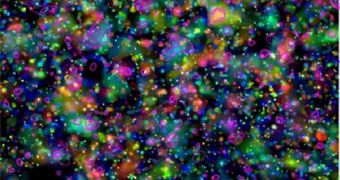One of the most difficult-to-achieve goals in astrophysics today is establishing the approximate weight of the universe. This can be done by combining two sets of data, one that estimates the mass of all visible matter in the Universe, and another that attempts to put some values on the mass of dark matter that lurks about undetected. In a new scientific research, experts were able to make such measurements of groups of galaxies more distant and smaller than thought possible. The group concluded that, regardless of their distance into the inner Universe, galaxies tended to form within the same proportion of dark matter as larger, closer galaxies, Space reports.
The new findings, astrophysicists say, could help them get more clues about dark matter, how it acts, and how it interacts with regular matter. Up until now, there has been no direct observation of dark matter, and physicists have only attempted to infer its properties, and the kind of particles it could be made out of. This line of research, experts say, could also be used to gain more insight into the other force that appears to be playing a massive role in the Universe, dark energy, the engine behind the Cosmos' ever-accelerating expansion.
Scientists employ a number of highly complex processes in determining the ratio of normal matter to overall matter (the mass-luminosity relation, or MLR). The theory is fairly straightforward. As clusters of galaxies move closer together, their dark matter combines and generates an increased gravitational pull on the galaxies in the cluster. This in turn wraps the space-time around the structure, causing the light reaching the Earth's telescopes to appear distorted. This gives researchers an idea of the mass the galaxies or clusters have. Then, they look at the same group with X-ray telescopes, which capture light that comes only from normal stars and galaxies within the cluster (normal matter).
The difference makes up the MLR. The thing about this technique is that it has only been used on nearby galaxies until now, on account of the fact that no valid, detailed sets of X-ray data were available on the most distant clusters. “We can map out the big cities, but no one's been able to map out the villages yet,” the leader of the new study, Alexie Leauthaud, says. He is a physicist at the California-based Lawrence Berkeley National Laboratory (Berkeley Lab), which is managed by the US Department of Energy (DOE).
The experts' improvements on the existing method were only made possible by incorporating data from some of the world's most advanced telescopes. The XMM-Newton satellite, operated by the European Space Agency (ESA), and the Chandra and Hubble space telescopes (both of the American space agency NASA) contributed to the data sets, which provided a massively improved view of the distant Universe. “We didn't know what to expect going down to lower masses or [farther distances], and we find this nice simple relationship. Now the aim is to find out why we find this nice, simple relationship,” the expert says. “We want to try to understand the properties of dark energy. One way to measure properties of dark energy is to measure the number of structures that have formed for a given amount of dark matter,” he concludes.

 14 DAY TRIAL //
14 DAY TRIAL //